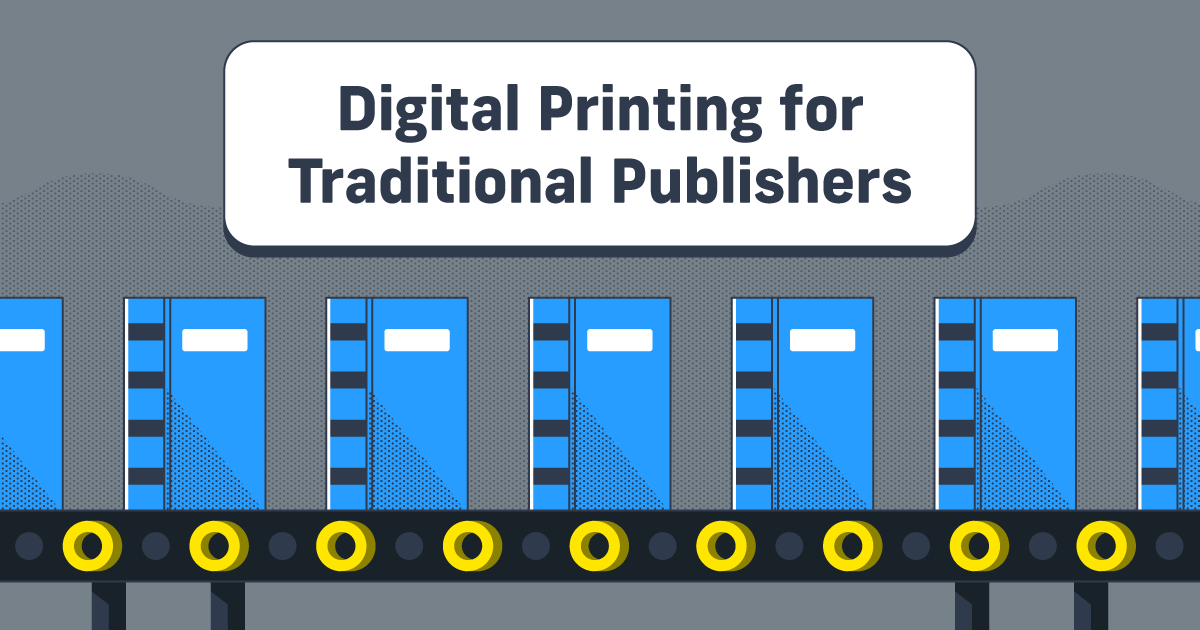Direct-to-Consumer Bookselling
Selling a book used to mean store shelves. That was the goal; to have your book in a bookstore or big-box retailer. Then the internet came along and a little company named Amazon ushered in a new way to buy books (and eventually everything). Today, we’re stepping further into the future with another innovation in the way we sell books; direct to consumer sales.
If you’re preparing to publish a book for sale or you’ve already got one (or more) listed on retail sites, direct-to-consumer sales will be critical to your long-term success.
The Days of ‘Amazon and Done’ Publishing
As Amazon rose to dominance in the ecommerce retail space, the common advice for authors looking to publish was to simply use Amazon. First CreateSpace, then Kindle Direct (or KDP), made it easy to upload a file, add the book’s details, and get published. In little time and with minimal effort, your book would appear for sale on the world’s most important retail site.
From the early 2000s up until just recently, writing groups and forums generally agreed that self-publishing and Amazon were essentially synonymous. Other, specialized platforms like Lulu and Blurb offered the same thing as Amazon (including distribution to Amazon’s marketplace). Ingram’s self-publishing service (IngramSpark) is a pipeline to Amazon too.
The importance of Amazon as a retailer isn’t changing. But the way we sell books (and other products) is. Feeding your book into the retail Goliath isn’t the only (or even the best) option for authors today.
How Direct-to-Consumer Works
Many years ago, I went to a Comic-con event and found a board game I wanted to buy. But I’d spent all my cash and my friends didn’t have enough to cover it either. I had my credit card though. And the vendor had this carbon copy machine she used to make an imprint of my card on the receipt.
That was a direct-to-consumer transaction. It was kind of a pain in the ass.
Luckily, in 2010 Square introduced the first mobile phone-based card reader. From there, the boom in ecommerce has grown steadily until last year, when it absolutely exploded during the pandemic.

It makes sense; we were all ordering online more. We had to.
This accelerated growth means we’ve also seen 10 years of innovation, marketing, and experimentation in a little over a year. Services like Shopify, Wix, and WooCommerce are improving at an accelerated rate too; rushing to keep up with the demands of their users.
Now Is the Time: Sell Your Book
There’s never been a better time than now to develop and market a brand. All you need is access to an audience, a product to sell to that audience, and a means to make those sales.
The internet makes all three possible, but the final point has long been handled by a retailer. A wholesale model; with all the inherent dangers of a longer supply chain.
And people are reading more than ever too! Literally, this is your moment. The tools are there. The audience is there.

Sell Your Book, Your Way
Sell books on your Wix, Shopify, or WooCommerce website with Lulu Direct.
Or use our Order Import tool for your next book launch.
How to Sell Your Book Direct To Consumer
Okay, a lot goes into selling anything. First and foremost, you need an audience.
That’s not exactly what this post is about, but we’ve got this post about building your brand and an episode of Lulu University to help get you started.
Now you need a way to sell your book. That’s where ecommerce platforms like Shopify come in. Your ecommerce platform manages the shopping pages and cart—giving readers the ease and security of any big retail site.
After that, you need a website to host your shopping pages (and a blog, bio, and maybe some videos).
Finally, you need your book! You could order 1,000 copies and store them in your garage, running to FedEx to ship each order individually. Or you could connect your Shopify store to Lulu Direct and use our print-on-demand network to fulfill your orders.
Sell Like a Professional Author
If you opt to use Shopify, Wix, or WooCommerce with Lulu Direct, you cut out a huge amount of overhead (down to as low as $9 a month for Shopify). Print-on-demand means you don’t need to keep books in stock. Your entire business could fit in a laptop.
This frees you up to focus on the hard part; writing and editing books while maintaining and growing that audience.
Fortunately, with 57% of consumer brands embracing direct-to-consumer selling, you’ve got plenty of sources for information. You can find a bunch of big and small brands in this Shopify article.
Lots of really cool bookselling websites exist too. Like Honeycomb Collective, a company selling astrology almanacs. Astrology calendars and planners are popular and could sell on a retail site. But selling directly means you stay on their site when you shop, you are prompted to join their mailing list, and you keep your shopping data with the retailer.
Another cool example is Red Panda Books. You use their website to personalize a book for your kids, then they ship you a printed copy! Simple but unique, Red Panda Books wouldn’t work as well on a retail site, so they really need direct-to-consumer ecommerce!
A Critical Look
I’m going to use Gretchen Rubin’s beautifully designed website as an example of the OLD way. Here’s a screenshot of her Books page:

Here you see her most recent book. When I click BUY NOW I get a list of links to retailers. I click AMAZON and five minutes later I have her book, a 3 lbs bag of Skittles, and Barry the grater arriving in a couple of days.
As the bookseller, this is concerning because your reader is being distracted from their initial search (the book) by all these other retail products. On top of that, they complete the transaction on another website. There’s a very good chance that the reader never goes back to your site.
And look at where her newsletter sign-up is placed. If I came to her site to buy her book, I’ll be on Amazon before I even think about giving the author of the book my information.
If Rubin were selling her book using her own ecommerce platform, she’d be able to point that BUY NOW button to a shopping cart. She’d have the order data and the opportunity to get an email follower.
Nothing about direct-to-consumer retail precludes you from putting your book on Amazon, Barnes & Noble, Bookshop, and others. This is about maximizing sales of the audience you can direct to your own website.
Challenges Of Direct Sales
So far, I’ve been all sunshine and flowers about ecommerce. But if it really was that easy, wouldn’t everyone be doing it? Nothing is ever that easy, but to be sure a lot of people are using ecommerce.
There’s no shortage of other authors and book-makers out there too. If you want to sell your books directly to your readers, you’ve got a lot of work ahead of you.
Remember too those direct sales strategies are a long game. You’ll earn more per sale (and ideally books will still sell on retail channels too) but the real goal is to capture that reader’s interest in you. That’s how you earn the kinds of fans who buy everything you publish.
Winning Search
Search engine optimization (SEO) is an important part of the puzzle for some sellers. For most, I suggest treating it like a best practice. You should optimize your author website, but you shouldn’t do so expecting it to drive that much traffic.
That’s because the biggest companies with entire teams of skilled writers and designers are already fighting over those top spots. Trying to oust these companies from Google’s results page would involve a lot of time and effort—both of which you can better apply to other tasks.
But there is one piece of optimization you should be very aware of; your brand terms. That includes your author name, the titles of your books, and any other relevant terms (like ‘hobbits’ would be a very relevant term if I were J.R.R. Tolkien and I wanted to build an author website).
Reputation and Networking
Earning new readers through Google or Amazon search is hard, but building a network of fellow writers and readers is manageable. I mentioned this post about networking earlier; you’ll want to support those efforts with a clean website that screams ‘professional!’
Because you’re not just writing books you’ll also need to manage your reputation too. Every social post or comment and every sale on your author site is a moment of contact that can be positive or negative. Small businesses (which is what your author site is) rely on a stellar reputation to get ahead.
Lucky for you, interacting on social media sites and writing forums builds up your reputation and expertise while expanding your network. If your goal is to drive more sales to your own website, networking and reputation are the most important paths to pursue.
Being an Author Is a Full-Time Job
Perhaps the biggest challenge for direct-to-consumer booksellers is time. You need to write the books and do some of the editing (hopefully not ALL the editing). You also need to create content for your site (like blog posts or videos) and be present on social media.
Creators of all kinds are embracing the entrepreneurial view of the world. It’s an amazing opportunity for more authors and bookmakers to earn a living doing what they love.
It’s a lot of work, but the potential reward makes it worth it.

Create Your Book
Use Lulu's free templates to easily create and publish your book today.
Going Wide; Be Where Readers Are
Marketers like to create little phrases and acronyms for everything. ‘Going wide’ just means selling your product on a variety of platforms. It’s the opposite of exclusivity.
In the self-publishing world, there has long been a debate about the benefits of each method. Exclusivity can build hype and (like Amazon’s Select/Unlimited program) you gain access to some of the platform’s own advertising features. Going wide means you’re managing your book in more locations, but you also have exposure to readers on those platforms.
I firmly believe going wide is the right path for authors. However, I think there needs to be a rethinking of the ‘going wide’ model.
Historically, going wide meant listing your book everywhere and earning revenue based on the royalty rates of those platforms. Which is great. Earning money from your book is kind of the point, right?
What needs to change, and what is changing thanks to ecommerce, is the next step. In the old model, that buyer has bought the book. That’s it. Done.
Authors today have the ability to treat those retail channels as a marketing funnel. Put your author website everywhere you can. That includes inside the book, on your author page on every retail site, on the book description; and everywhere you can. Your website is the end goal of every sale on a retail channel.
Yes, they’ve already bought a book, so that’s great. But if you can make them a fan by getting them on your site, reading a blog, or watching a video; you can earn their subscription and get them on your mailing list. That’s how you get fans who buy ALL your books.
Changing Times
Direct-to-consumer tools like Shopify and Lulu Direct give you an opportunity to build your own brand. Creators have never had such a wide-open opportunity to control their creations and how those creations are monetized. If you’ve created a book, whether it’s a gripping novel, a cinematic photo journal, or a guide to wiring airplanes; you can publish and sell it to your audience directly.




